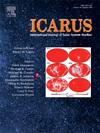A controlled mosaic of Moon Mineralogy Mapper (M3) reflectance data in the lunar polar regions for understanding the mineralogy and water of the Artemis exploration zone
IF 2.5
2区 物理与天体物理
Q2 ASTRONOMY & ASTROPHYSICS
引用次数: 0
Abstract
This study presents high-resolution (140 m/pixel) controlled mosaics of Moon Mineralogy Mapper (M3) data in the lunar polar regions (80°–90° N/S), with a focus on assessing mineralogy and water content across the Artemis exploration zone. M3 extensively sampled the lunar polar regions, providing a high spatial resolution, hyperspectral imaging dataset that uniquely covers reflectance absorptions of major minerals and water on the lunar surface. We developed a methodology to preferentially use M3 image cubes acquired when the star tracker was operational to ensure accurate spatial registration of M3 pixels in our new mosaics. Integrated band depth (IBD) analyses were conducted to map distributions of hematite and other mineral species at the Artemis exploration zone. We also derived water contents at the Artemis sites from our new M3 mosaics. Our findings indicate that the Artemis exploration zone is largely dominated by mature regolith that is probably rich in plagioclase. Hematite is predominantly concentrated on east-facing slopes, likely due to enhanced oxidation from Earth wind oxygen interacting with the lunar regolith. Pyroxene-rich exposures are observed in three Artemis candidate landing regions and they are all associated with fresh impact craters. The water distribution is highly variable, with higher concentrations on pole-facing slopes and near permanently shadowed regions, likely controlled by low surface temperatures. High water contents are observed at hematite exposures, which reinforces that water may play a crucial role in hematite formation on the Moon. These results provide valuable insights for future lunar exploration, aiding in the selection of landing sites, planning of traverse routes, and informing in situ resource utilization (ISRU) for the Artemis missions.
月球矿物绘图仪(Moon Mineralogy Mapper, M3)反射率数据在月球极地地区的受控拼接,以了解Artemis勘探区的矿物和水
本研究展示了月球极地地区(80°-90°N/S)月球矿物绘图仪(M3)数据的高分辨率(140 m/像素)控制马赛克,重点评估了Artemis勘探区的矿物学和含水量。M3对月球极地地区进行了广泛采样,提供了高空间分辨率的高光谱成像数据集,该数据集独特地涵盖了月球表面主要矿物和水的反射吸收。我们开发了一种方法,优先使用星跟踪器运行时获得的M3图像立方体,以确保我们的新马赛克中M3像素的精确空间配准。利用综合波段深度(IBD)分析方法绘制了Artemis探区赤铁矿及其他矿物的分布。我们还从新的M3马赛克中提取了阿尔忒弥斯遗址的含水量。结果表明,阿尔忒弥斯探区以成熟风化层为主,可能富含斜长石。赤铁矿主要集中在朝东的斜坡上,可能是由于地球风氧与月球风化层相互作用而增强的氧化作用。在阿尔忒弥斯的三个候选着陆点观察到富含辉石岩的暴露,它们都与新的撞击坑有关。水的分布变化很大,在面向极点的斜坡和永久阴影区域附近的浓度较高,可能受到地表低温的控制。在赤铁矿暴露处观察到高含水量,这加强了水可能在月球赤铁矿形成中起关键作用的观点。这些结果为未来的月球探测提供了有价值的见解,有助于选择着陆点,规划穿越路线,并为阿尔忒弥斯任务提供原位资源利用(ISRU)信息。
本文章由计算机程序翻译,如有差异,请以英文原文为准。
求助全文
约1分钟内获得全文
求助全文
来源期刊

Icarus
地学天文-天文与天体物理
CiteScore
6.30
自引率
18.80%
发文量
356
审稿时长
2-4 weeks
期刊介绍:
Icarus is devoted to the publication of original contributions in the field of Solar System studies. Manuscripts reporting the results of new research - observational, experimental, or theoretical - concerning the astronomy, geology, meteorology, physics, chemistry, biology, and other scientific aspects of our Solar System or extrasolar systems are welcome. The journal generally does not publish papers devoted exclusively to the Sun, the Earth, celestial mechanics, meteoritics, or astrophysics. Icarus does not publish papers that provide "improved" versions of Bode''s law, or other numerical relations, without a sound physical basis. Icarus does not publish meeting announcements or general notices. Reviews, historical papers, and manuscripts describing spacecraft instrumentation may be considered, but only with prior approval of the editor. An entire issue of the journal is occasionally devoted to a single subject, usually arising from a conference on the same topic. The language of publication is English. American or British usage is accepted, but not a mixture of these.
 求助内容:
求助内容: 应助结果提醒方式:
应助结果提醒方式:


